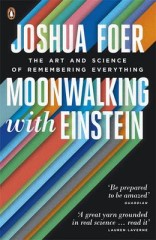Moonwalking With Einstein: The Art and Science of Remembering Everything
Joshua Foer, Allen & Unwin ($30)
How to Memorize Everything, a review by Alexandra Horowitz of the New York Times:
When we meet Joshua Foer, his memory is “nothing special.” A year later, he is able to memorize the order of a shuffled deck of cards in less than two minutes and the names of 99 people he’s just met. He has also etched in his brain images of his friend urinating on Pope Benedict’s skullcap, of Rhea Perlman involved in indelicate acts with Manute Bol, and of other things most of us would try hard to forget. Let it never be claimed that there is no cost to self-improvement.
A mere millennium ago, being able to remember and recite a text verbatim was not a game or a party trick. It was an art. More than that, it was part of being cultured: a person without memory was a person without ethics or humanity. Today, memorization is limited to Shakespeare monologues and Robert Frost poems in high school. Phone numbers and friends’ birthdays are “remembered” by cellphones and computers. Indeed, much of our daily memory has been offloaded onto external devices. The advantage to this is clear: information is portable and searchable, and not taking up valuable space in our noggins. Until you lose your iPhone.
Still, memory is intricately tied to identity; we are a product of our own experiences. What we perceive is shaped by what we have perceived before; what we learn is bootstrapped on past learning. Amnesia seems to many so horrifying because it robs us of our own autobiography, and thus, it seems, ourselves. If on no other ground, most Americans are joined in our shared desire to improve the curious, elusive faculty we call “memory.”
Foer, a freelance journalist, stumbles upon the realm of memory improvement accidentally. Searching for the world’s “smartest person,” he settles on a marginal event called the U.S. Memory Championship as a likely place to find such a specimen. The reduction of intelligence to memory is questionable, but never mind: Foer, like the rest of us, cannot help being captivated by the achievements of the “mental athletes” who compete in these events, like memorizing 27 decks of shuffled cards in an hour, or 4,140 binary digits in half that time.
“Anyone could do it,” these athletes claim, belying the countless hours they have spent training. Foer aims to prove it when he goes from standing on the sidelines at the 2005 U.S. Championship to throwing himself into a mental brand of George Plimptonesque participatory journalism. By 2006, Foer is onstage at the same event with three dozen other mnemonists, armed with earplugs and noise-reducing headphones to minimize distractions.
In “Moonwalking With Einstein,” Foer charts his journey from observer to headphoned memorizer, with forays into the Renaissance “art of memory,” cognitive neuroscience, chicken sexing and the history of indexes. He submits to psychological testing and acquires a coach, Ed Cooke, himself a memory-games competitor. Meeting Cooke, who represents the crashing together of youthful exuberance and mind-boggling commitment to mnemonics, is one of the many pleasures of Foer’s book. This is a fellow who constructs a network of entrance tunnels to his own birthday party, through which guests must struggle on their bellies, in order to make the party maximally memorable.
The art of memory is credited to the ancient Greek poet Simonides, who was able to perfectly recall the scene in a banquet hall moments before the roof collapsed, simply by reviewing it in his mind’s eye. The “method of loci” assigns distinctive images to anything one wants to remember, placing the images in familiar rooms or buildings. Recalling, then, becomes a matter of traveling through those locations, or “memory palaces,” and noting the images assembled there. This seeming sleight of hand – memorize X in order to remember Y – takes advantage of a simple fact of human cognition: we naturally remember visual images. Take a moment to imagine your own living room; a detailed description of everything in sight is effortless.
Translating your shopping list into something memorable involves choosing good images and good loci – and then concentrating on them. The less banal, the better. Quotidian scenes are forgettable. What snags the cells of our brains are disgusting, bizarre and novel images.
Using a version of these ancient techniques, a past world memory champion named Ben Pridmore was set to prove he had memorized 50,000 digits of pi. (Trumped by a man who recited pi to 83,431 places, Pridmore spent the next six weeks cleaning the images of pi out of his memory palaces.) In joining their ranks, Foer develops various loci, including friends’ houses, his old high school, and Camden Yards. He mentally collects a population of images – often lewd or ridiculous – which he will assign to numbers, playing cards or whatever else he will need to memorize. (Hence his title, which represents the combination of images he uses to remember the four of spades, the king of hearts and the three of diamonds.) In this way, a long string of numbers becomes a farcical tour of fantastical images, distributed in a memory palace. They almost don’t need to be memorized, per se. Once you attend to them, it is hard to forget them. Dom DeLuise hula-hooping plays a pivotal role for Foer, as does an earring-wearing Incredible Hulk on a stationary bike.
Irregular images aside, Foer’s missteps are few. Discussing the neurological underpinnings of memory, he repeats some commonly held myths about it, for instance, that obscure facts -‘where I celebrated my seventh birthday” – are “lurking somewhere in my brain, waiting for the right cue to pop back into consciousness.” In fact, not only are many such memories lost for good, even the memories we do have are often quasi-fictionalized reconstructions. Foer inexplicably devotes space to attempting to convince the reader that Daniel Tammet, a renowned savant who memorized 22,514 digits of pi, may not actually be doing it naturally, but only by using the same kind of mnemonic aids used by Foer and his fellow competitors (would it matter?). And at times he seems to have lost some perspective on his endeavour, as when he states, without apparent irony, that the Memory Championship, begun “as a one-day contest” 20 years ago, “has now expanded to fill an entire weekend.”
But Foer is too engaging to put us off. His assemblage of personal mnemonic images is riotous. He makes suspenseful an event animated mostly by the participants’ “dramatic temple massaging.” By book’s end, Foer can boast the ability to memorize the order of nine and one-half decks of cards in an hour. Yet he still loses track of where he left his car keys like the rest of us. He numbly types into his cellphone the phone numbers he does not want to bother to remember. And one can only imagine what he will do with the fantastical images that now people his brain.
We cannot be too disappointed that Foer’s mnemonic immersion did not make him the world’s smartest person. Not everything is equally important to remember. And most things worth remembering are precisely unlike a deck of cards: memories of your own life are spindly, slippery things, interwoven and ever changing. But Foer has given us a hula-hooping Dom DeLuise, and perhaps the fortitude to try memorizing that favorite high school poem again. This time with pictures.




